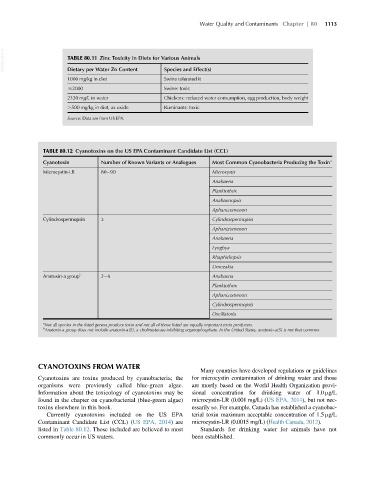Page 1181 - Veterinary Toxicology, Basic and Clinical Principles, 3rd Edition
P. 1181
Water Quality and Contaminants Chapter | 80 1113
VetBooks.ir TABLE 80.11 Zinc Toxicity in Diets for Various Animals
Dietary per Water Zn Content
Species and Effect(s)
1000 mg/kg in diet Swine tolerated it
$2000 Swine: toxic
2320 mg/L in water Chickens: reduced water consumption, egg production, body weight
.500 mg/kg in diet, as oxide Ruminants: toxic
Source: Data are from US EPA.
TABLE 80.12 Cyanotoxins on the US EPA Contaminant Candidate List (CCL)
Cyanotoxin Number of Known Variants or Analogues Most Common Cyanobacteria Producing the Toxin a
Microcystin-LR 80 90 Microxystis
Anabaena
Planktothrix
Anabaenopsis
Aphanizomenon
Cylindrospermopsin 3 Cylindrospermopsis
Aphanizomenon
Anabaena
Lyngbya
Rhaphidiopsis
Umezakia
Anatoxin-a group b 2 6 Anabaena
Planktothrix
Aphanizomenon
Cylindrospermopsis
Oscillatoria
a
Not all species in the listed genera produce toxin and not all of those listed are equally important toxin producers.
b
Anatoxin-a group does not include anatoxin-a(S), a cholinesterase-inhibiting organophosphate. In the United States, anatoxin-a(S) is not that common.
CYANOTOXINS FROM WATER
Many countries have developed regulations or guidelines
Cyanotoxins are toxins produced by cyanobacteria; the for microcystin contaminationofdrinkingwater andthose
organisms were previously called blue-green algae. are mostly based on the World Health Organization provi-
Information about the toxicology of cyanotoxins may be sional concentration for drinking water of 1.0 μg/L
found in the chapter on cyanobacterial (blue-green algae) microcystin-LR (0.001 mg/L) (US EPA, 2014), but not nec-
toxins elsewhere in this book. essarily so. For example, Canada has established a cyanobac-
Currently cyanotoxins included on the US EPA terial toxin maximum acceptable concentration of 1.5 μg/L
Contaminant Candidate List (CCL) (US EPA, 2014) are microcystin-LR (0.0015 mg/L) (Health Canada, 2012).
listed in Table 80.12. Those included are believed to most Standards for drinking water for animals have not
commonly occur in US waters. been established.

